|
|
The Quodlibet as Represented in Bach’s Final Goldberg Variation BWV 988/30
By Thomas Braatz (January 2005) |
|
Bach’s use of the quodlibet in ‘Variatio 30’ of the Goldberg Variations BWV 988 in many ways does not conform to the usual definition of ‘quodlibet.’ Bach, ever the innovator, goes beyond the limitations of the established form and function of the quodlibet and elevates it to new heights far beyond the usual inane, non-sequitur combination of incipits and snippets derived from popular folksongs and presented as humorous entertainment. To be sure, some of the folksong quotations that Bach uses here provide for comic relief in a composition designed for serious study and practice by musicians/composers (despite, or in addition to, Bach’s claim that Klavierübung IV [this means ‘Keyboard Practice’ after all] was ‘dedicated to providing delight to the souls of connoisseurs (non-performers/composers’ – [“Denen Liebhabern zur Gemüths-Ergetzung verfertiget.”]) A closer examination of the 30th variation will reveal that Bach did not intend it as a final ‘throw-away,’ ‘filler’ variation simply to amuse the audience with a few incongruous snippets of melody seeming to have little or nothing to do with all the previous variations nor, as suggested by a Bach scholar, a “Kehraus” [the long, fast, final wild dance of the evening with which the women swept the floor clean with their dresses.] On the contrary, it serves as a quasi-summary while also functioning as a bridge to what will follow or even toward a possible extension of the series and it is a prime example of the consummate artistry of Bach as a composer. |
| |
|
What Bach accomplishes in this variation |
|
In order to highlight more effectively the distinctive, recognizable elements contained in this variation, I have used capella notation software to render the NBA V/2 BWV 988/30 printed music in a form more easily recognizable at a glance than specific references to measure numbers and voice parts would be. Refer back to this illustration as needed: |
|

|
|
Here are items worthy of note:
1) The opening bass line is one of the few clear statements of the underlying bass melody for the entire set of variations. It is found in the ‘Aria’ and Variation 22 expressly stated. Its purpose in the Quodlibet is to return back it back to its basic original form, a form also stated clearly in BWV 1087 as the first of the canons listed there. It is printed here in dark blue.
2) The first of the two famous folksongs quoted, “Ich bin so lang nicht bei dir g’west,” begins with the very first note in the tenor (in red.) The text is placed above it as closely as possible. The continuing musical line (dark green) is still a part of the first line of this melody and text (the text is now below the notes.) This section of the melody is frequently lost ‘in the shuffle’ and sometimes it is not even mentioned at all. (Schulenberg and Williams seem to overlook it entirely.)
This folksong is first presented as a ‘Canone all’ Ottava’ with its second entrance in the descant coming a measure after the first one. This last entrance is once again repeated in the alto without any change of interval. Follow the red note markings and you will find the final entrance beginning with the pickup note at the end of the 12th measure, this time in the tenor as a ‘Canone alla Quarta’ compared to the first entrance. The conclusion of the first line of the folksong occurs only the first time at the very beginning (dark green.)
There is an interesting similarity of this folksong with a well-known chorale as well: |
|
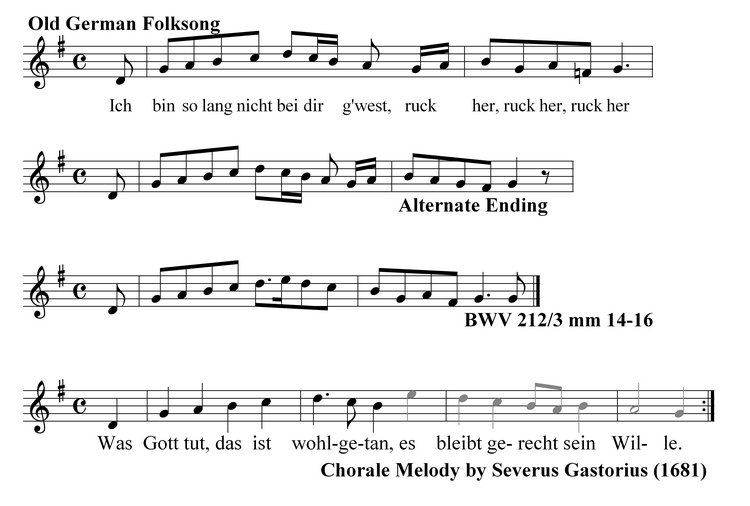
|
|
3) By far the most extensively exploited folksong is “Kraut und Rüben” (the German ‘Bergamasca,’ etc.) Its first verse is quoted entirely, however the concluding part “hätt’ mein’ Mutter Fleisch gekocht, wär’ ich länger blieben” occurs only twice at the end of each section of the variation, once in the tenor and finally in the soprano/descant. Somehow these ‘endings’ seem slightly out of place as they come in at the wrong octave or in a different voice than expected. This may be part of the humorous aspects of the quodlibet being expressed this way.
While the incipit of the first folksong is stated only 4 times throughout (3 times in the first section and only once in the 2nd ), the beginning of “Kraut und Rüben” (light green) occurs 4 times in each section. Now the canonic interplay becomes very interesting: the first entrance in measure 2 in the alto is quickly followed by the soprano/descant entrance in measure three. It is a ‘Canone alla Quinta’ In measure 5 the tenor restates the alto entrance as a ‘Canone all’ Unisuono’ albeit separated by a few measures this time. The final statement in the soprano/descant occurs over an octave higher as a ‘Canone alla Nona.’ Bach is recapitulating the same technique use in Variation 27. Beginning with measure 7, Bach simultaneously presents both halves of this folksong!. What follows in the second section of this variation is a quasi-stretto presentation of this folksong’s incipit: the alto begins the theme in m 9. This is followed in m 10 with a tenor entrance as a ‘Canone all’ Terza;’ [1] however, immediately thereafter, with only a half measure of separation, the alto restates, in stretto fashion, the theme a fourth higher (‘Canone alla Quarta.’) The final statement of the theme is left to the tenor while the soprano/descant simultaneously gives the conclusion of the song.
Elaine Sisman discusses the ‘Bergamasca’ connection in her article on ‘variations’ in the New Grove Online [Oxford University Press, 2004, acc. 1/8/05] as follows:
>> Many composers of south Germany and Austria luxuriated in lengthy passacaglias and chaconnes, with notable contributions by Biber, Kerll, Georg Muffat and Fux; each composed other types of variation as well. Unlike his extraordinary Passacaglia for solo violin (65 repetitions of the descending tetrachord, perhaps originating for a religious purpose), however, Biber's ostinato movements are not always labelled more specifically than ‘Variatio’ (e.g. Sonata no.3 for violin, 1681, on the descending tetrachord, or Sonata no.1 on the ‘bergamasca’ progression; the Mystery Sonatas also include many ostinato variations). Buxtehude, like Pachelbel an influence on J.S. Bach, imported the ostinato form into northern Germany, writing two ciaccone and a brilliant Passacaglia in D minor on four-bar themes as well as seven sonatas for violins and bass viol with ostinato movements. The Passacaglia presents a symmetrical structure of seven statements of the tonic-requiring bass in each of D minor, F, A minor and D minor. In the ciaccone the bass theme may be varied and moved from the pedals to the upper registers. In addition to chorale variations (one of which, ‘Auf meinem lieben Gott’, is actually a series of dance movements including a ‘double’) and suite ‘doubles,’ he also composed six sets of secular variations, including one on a Lully ballet melody (‘Rofilis’) and his most celebrated, ‘La capricciosa’ (buxwv 250). The latter uses as melody the song ‘Kraut und Rüben,’ found in the quodlibet (variation 30) of Bach's Goldberg Variations, and as the bass I–IV–V–I pattern of the ‘bergamasca’ (twice in each reprise). Also in G major and also with 32 sections (‘partite’), ‘La capricciosa’ has in common with the Goldberg Variations a multiplicity of topics and styles: quasi-imitative ‘canzona’ (2, 5, 15, 20 and the chromatic 12), brilliant ‘toccata’ (3, 6, 7, 11, 13, 16, 22, 26), lute-like ‘style brisé’ (10, 17 and the sarabande-like 25), gigue (9, 19) and tonic-pedal ‘lyra’ (18) styles (ex.7). In several variations the theme’s harmonies are altered to I–IV–V–vi, leading in variation 25 to a striking expansion in phrase structure (giving 10 bars in each reprise instead of four or eight). << |
|
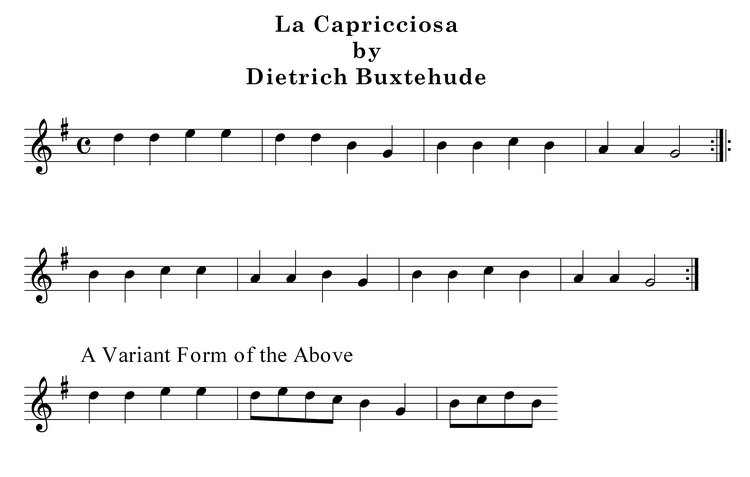
|
|
4) The tenor part in mm 3-4 of the 1st section of variation 30 cites a near replica of the melody (probably a folksong) used by Sweelinck in his famous set of variation“Mein junges Leben hat ein End’” (marked in light blue.) There are two other prominent downward scale passages, one beginning at the end of m 5 with a pickup note in the descant that jumps up a fourth before descending and another similar passage, and another, also in the descant beginning similarly at the end of m 9. It is one in m 5 which appears as a canon-like answer to the first statement in m 3. There are two potential objections to establishing this connection: 1) Bach has the first note in m 3 descend by a whole instead of by a half step as it does in Sweelinck’s use of the folksong melody; 2) the second statement of the melody as an interval leap at the very beginning, whereas the folksong melody does not. To resolve these apparent problems it is very instructive to ponder Bach’s utilization of themes with their near variants as seen, for instance, in BWV 127/1 (See: Cantata BWV 127 Mvt. 1: The Chorale Melody and Text) Bach modifies the incessantly repeated incipit of the chorale melody to suit his needs. He is much more concerned with the general ‘shape’ of the melody than the precise intervals between the notes. Since this is the case, I have posited in parentheses the missing note initiating the second statement of this theme. Notice that the on-the-beat accents and special emphasis on the trilled note is maintained.
Fortifying the validity of this connection is the fact that the words of the incipit provide an opportunity for Bach to indulge in ‘double entendre’ by equating the life, duration and conclusion of the Goldberg Variations with the subject of the song. |
|
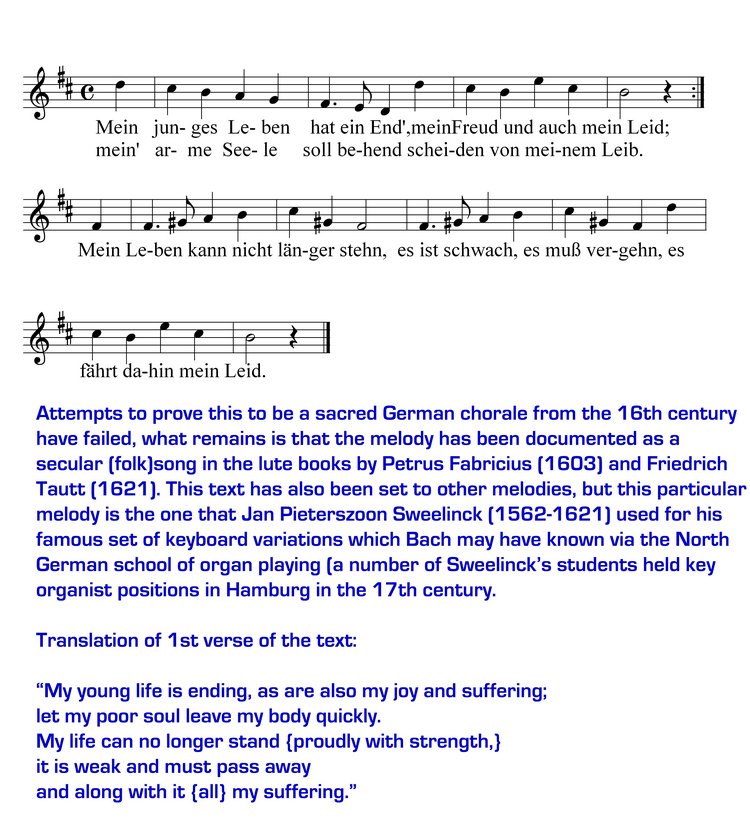
|
|
How fitting then for Bach to use this folksong in the same way as the other two, now more famous, folksongs “Ich bin so lang nicht…” and “Kraut und Rüben” through the canon-like use of its theme by having the second entrance a fifth higher (canone alla quinta) or actually an octave and a fifth higher than the first entrance. This theme is also remarkable because of its descending scale which figuratively has been extensively used in Bach’s word painting to express ‘death’ or the ‘end’ of things, a ‘catabasis.’
Still remaining to be identified are the following ‘tunes’: |
|
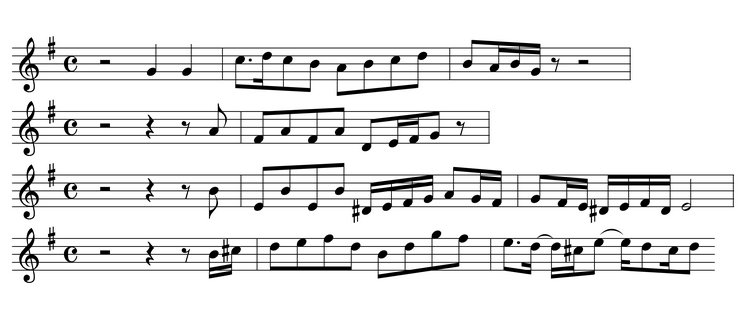
|
|
In discussing the ‘Vom Himmel hoch’ variations (BWV 769), Christoph Wolff on p. 350 of his book :”Bach: Essays on His Life and Music” [Harvard University Press, 1991] touches upon the quodlibet variation this way:
>>The growing intensity comes to a climax at the end of the concluding movement…with an extraordinary expression of contrapuntal density marked ‘alla Stretta’…culminating in six-part texture. The stretta (mm. 54ff.) is made up of a combination, or superimposition, of all ‘cantus firmus’ phrases that prior to this were introduced as separate soggetti. A comparison with the canonic climax in Clavier-Übung IV is instructive: the stretta is related in kind to the Quodlibet. The same principle of contrapuntal procedure, the combination of several themes locked in close canonic entries, in both works marks the point of finality and the crowning of the total structure.<<
It was D. F. Tovey in his “Essays in Musical Analysis” [London, 1935] who stated that the Goldberg Variations are “not only thirty miracles of variation-form, but…a single miracle of consummate art as a whole composition.”
Variation 30, often referred to as a ‘joke,’ can only be understood this way if one neglects to search for deeper meanings that exist on numerous levels. It stands Janus-faced looking back over what has transpired in the preceding variations (perhaps even over Bach’s own musical development) while also pointing another face towards that which might still come [Bach’s handwritten ‘etc.’ at the end of BWV 1087 (various canons based on the first 8 notes of the Goldberg ‘Aria’) indicating ‘to be continued’ or ‘and so on.’] |
| |
|
Critical Sources and Important (detailed) Commentaries: |
|
The following is the critical source description as contained in NBA V/1 KB which was prepared by Walter Emery and Christoph Wolff. The publishing date is 1982. The quotations are from pages 98, 109-112. [A translation of the text follows, but without the musical illustrations; for these refer back to the original German text] : |
|
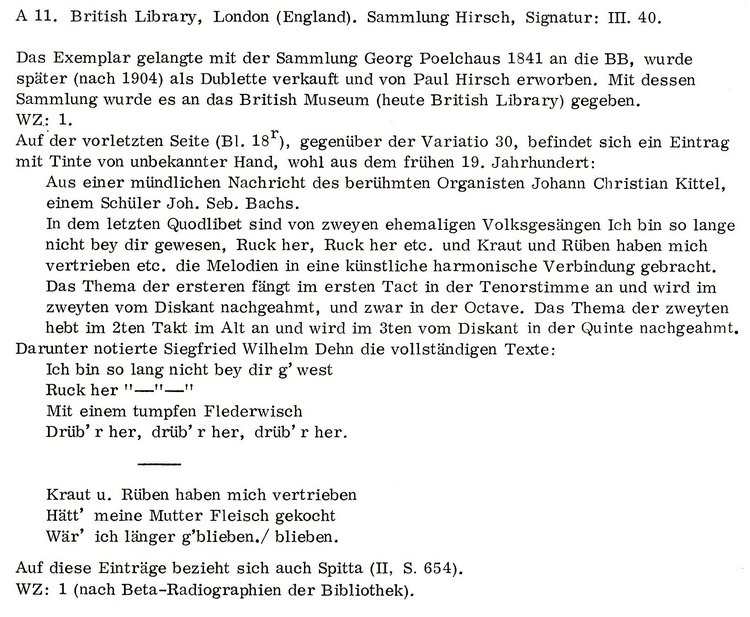
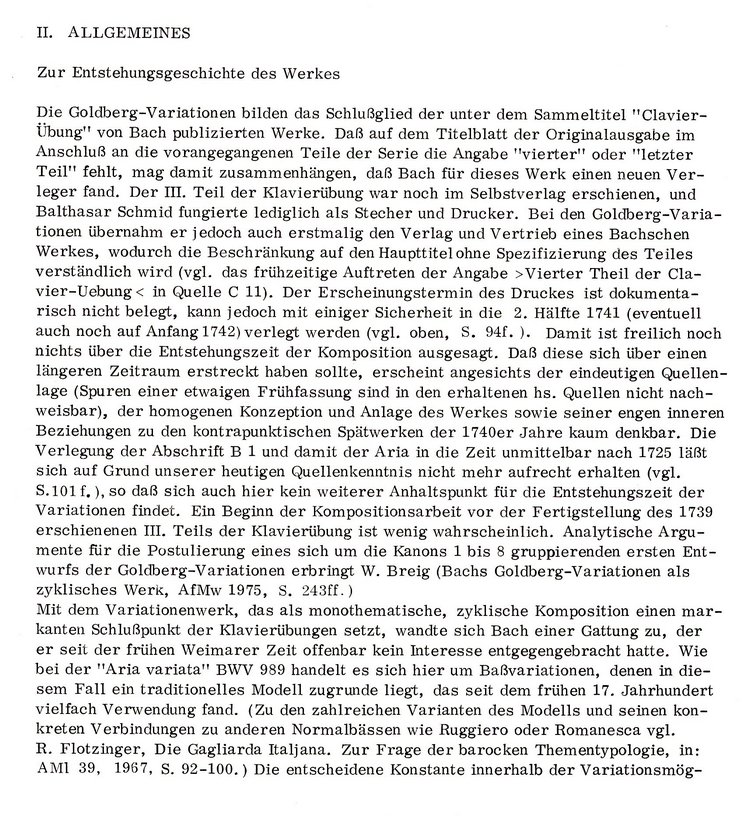
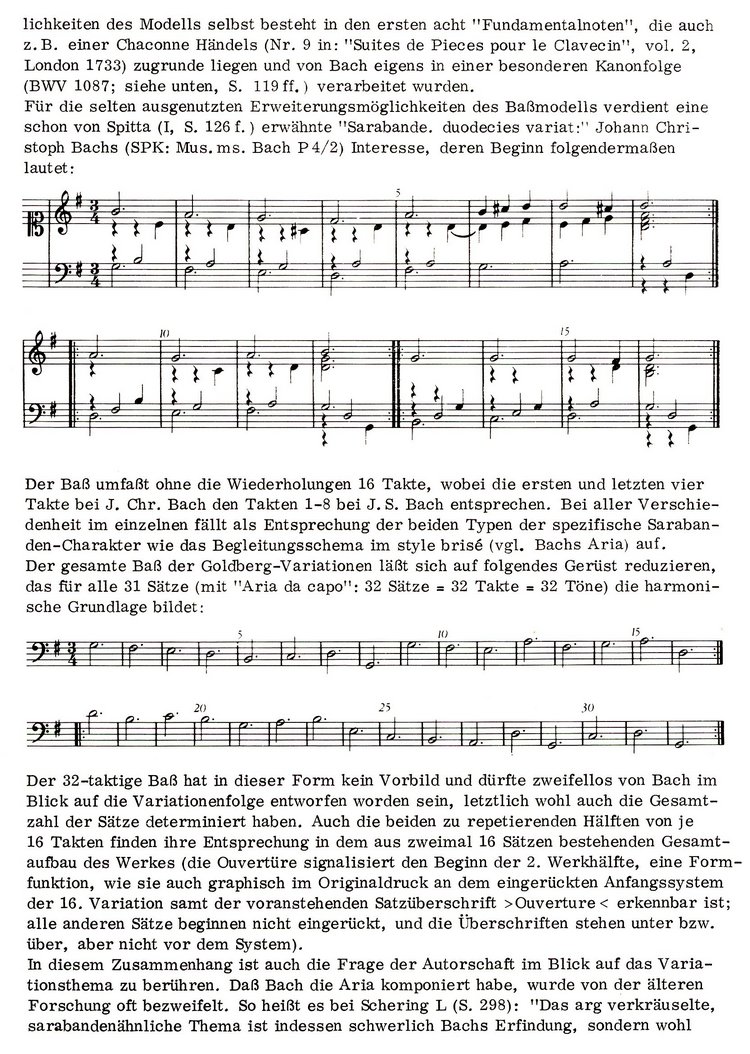
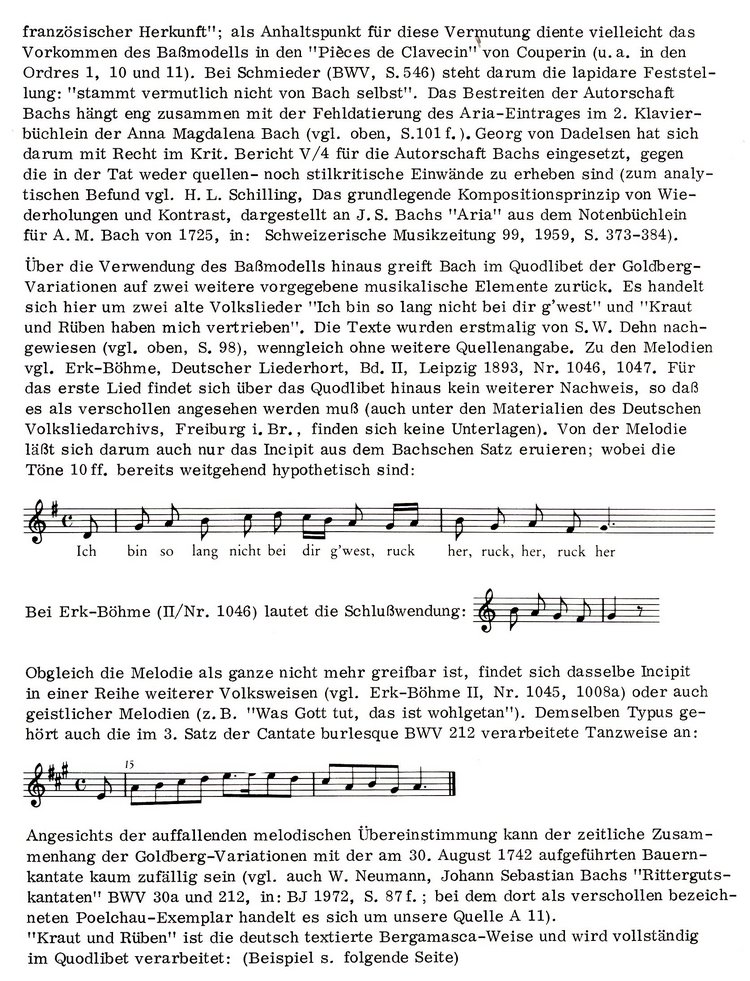

|
|
A 11. British Library, London (England). Hirsch Collection, Signature: III. 40.
This specimen copy was acquired by the Berlin State Library from Georg Poelchau’s collection in 1841 and was later sold (after 1904) as a doublet and purchased by Paul Hirsch. The latter’s collection was later donated to the British Museum (now British Library.)
Watermark: 1
On the penultimate page (page 18 r) facing ‘Variatio 30,’ there is an entry in ink by an unknown hand, probably from the early 19th century:
“By word of mouth given by the famous organist Johann Christian Kittel, a student of J. S. Bach:
‘In the final quodlibet, the melodies of two former folksongs “Ich bin so lange nicht bey dir gewesen, Ruck her, Ruck her” etc. and “Kraut und Rüben haben mich vertrieben” etc. are brought into an artistic, harmonic connection with each other [are combined harmonically in a very artistic manner.] The theme of the first begins in the first measure in the tenor part and is imitated in the second measure by the descant, specifically at the interval of an octave. The theme of the 2nd commences in the second measure in the alto part and is imitated in the 3rd measure in the descant at the interval of a fifth.’
Under this statement Siegfried Wilhelm Dehn has written the complete texts (of both songs.): [These translations are only conjectures based upon a number of possibilities suggested by the DWB.]
“I haven’t seen you for such a long time [haven’t been at your place/in your company]
Move over here [with a jerky movement as if retaining a sitting position on a bench]
Use your damp [goose-feather] duster,
All over me”
Another more remote possibility could be:
“I’ve been away from you for such a long time, why don’t you slide over here where I am sitting and with your dull sword come at me with full force [all over me.]” [This can only make sense if the figurative meaning of a shrew is assumed as characterized in “The Taming of the Shrew” by Shakespeare. In this situation the man who has been with a woman earlier, returns after considerable time has elapsed, and dares the bristly woman to treat him the same way again, as he realizes that she has spurned other suitors in the meantime and that time is now on his side as she must come to understand that she may end up as a spinster if she persists in acting the same way to him. Also the possibility exists that the returning wanderer is ‘brushed off’ {with a feather duster} once again by the woman whose attention he wishes to gain.]
The last, craziest possibility might be to consider ‘Flederwisch’ = “Zippelpelz” [remember Bach’s documented use of the dialect form “Zippel Fagottist” in referring pejoratively to Johann Heinrich Geyersbach’s playing ability on the bassoon], but how can these two halves of the 1st verse be connected now? Is there some kind of crude sexual allusion involved in the final two lines? I will allow the reader to decide just how far this kind of interpretation can be taken. Peter Williams summarizes below the tradition of the ‘Quodlibet’ as involving “making music by singing successively or simultaneously various popular tunes, often with racy texts.”
Here are some notes regarding certain key words:
Tumpf = dumpf = damp, also dull
‘Flederwisch’ = Feather brush or duster usually made of goose feathers, sometimes used for dusting off people’s clothes
‘Flederwisch’ = ‘Zippelpelz’ a Silesian term for a fur camisole or coat made of lamb or sheep tails with two tips hanging down the back (worn primarily by rural folk.) An interesting quotation from 1625 reads: “wenn die leutlein zu tische gesesein, und mahlzeit haben halten wollen, so sind die meuse auff die bäncke gekrochen, und haben ihnen von hinden zu die zippelpeltze abgefressen.“ [When people sat at the table and wanted to eat their meal, the mice crawled up and onto the benches and ate off from behind their ‚Zippelpelts.’]
Other figurative meanings of ‘Flederwisch’ include: a stand-offish virgin, a demure girl, a ‘tumpf’ = ‘dull’ or ‘damp’ = sword/saber
Drüb’r her = All over it/me [coming in my direction and covering me]
The second song is much easier to make sense of:
“Cabbage and beets have driven me away
If my mother had cooked meat [instead]
I would have stayed around much longer.”
[This could have been a song sung by apprentices and journeymen who worked under a master whose wife served as a surrogate mother who cooked for all the men on the premises.]
Spitta [II, p. 654] refers to these entries.
|
|
Watermark: 1 (using the library’s beta-radiograph) |
|
II. Topics of a General Nature
Concerning the Origin of the Composition
The Goldberg Variations are the final part of the series entitled “Clavier-Übung” [‘Keyboard Practice’] which Bach had published. The fact that the title page of the original edition lacked the extension found on the previous parts and did not indicate it as the ‘fourth’ or ‘last’ part, may be due to the fact that Bach had found a new publisher for this part. The 3rd part of the ‘Clavier-Übung’ had still been published privately by Bach himself whereby Balthasar Schmid simply functioned as the engraver and printer under Bach’s direction. In the case of the Goldberg Variations, however, he [Schmid] assumed for the first time the publication and distribution of a composition by Bach, thus the limitation in the title without further specification becomes understandable (cf. the early appearance of the indication “Fourth Part of the Clavier-Uebung” in source C 11.) The exact publishing date can not be documented, but with some certainty must have occurred in the 2nd half of 1741 (possibly even the early part of 1742 (cf. above, p. 94ff.) This, of course, does not tell as anything about when this work was composed. Based upon the clear evidence offered by the source materials (no traces of a supposed ‘early’ version can be found), it is hardly conceivable that the process of composition would have stretched over an extended period. Likewise speaking against such a longer period of gestation are the homogeneous conception and design of this work as well as its close connection with the contrapuntal late works of the 1740s. Trying to place Bach’s ‘Handexemplar’ and AMB’s copy of the ‘Aria’ in her “Notenbüchlein” as having occurred soon after 1725 is no longer feasible in light of our knowledge today about these sources (cf. p. 101 ff.) so that there is really no basis upon which such an assumption regarding Bach’s early occupation with this music can be established. There is little probability that Bach would have started working on it before completing Part III of the ‘Clavier-Übung’ in 1739. Analytical arguments suggesting a first draft of the Goldberg Variations as being based upon the canons 1 to 8 were produced by W. Breig (Bach’s Goldberg Variations as a Cyclical Work, AfMw 1975, pp. 243ff.)
With this set of variations which provide as a monothematic, cyclical composition a striking conclusion for the ‘Clavier-Übungen,’ Bach had returned to a composition form for which he obviously showed little interest since his early Weimar days. Just as in the case of the ‘Aria variata’ BWV 989, here also it concerns the bass variation form, for which, in this case, it is based upon a traditional model which had been frequently used since the beginning of the 17th century. [Regarding the numerous variants of this model and its actual connections with other normal bass types like the ‘Ruggiero’ or the ‘Romanesca’ see R. Flotzinger, “Die Gagliarda Italjana. Regarding the Typology of Baroque Themes” in AM1 39, 1967, pp. 92-100.) The decisive constant among all the variable possibilities [possibilities for creating variations] consists of the first 8 ‘fundamental notes,’ which, for example, underlie a chaconne by Handel (No. 9 in “Suites de Pieces pour le Clavecin” vol. 2, London 1733) and which were specifically treated as a special canon sequence by Bach (BWV 1087, see below, p. 119 ff.)
Serving as an example of one of the seldom used possibilities for expanding the bass model, a ‘Sarabande, duodecies variat:’ by Johann Christoph Bach, already referred to by Spitta (I, p. 126 ff.) deserves mention. Its beginning looks like this: |
|
Example |
|
The bass line comprises 16 measures without the repeats. Of the latter, the 1st and last 4 measures in J. Chr. Bach’s composition correspond to the first 8 measures in J. S. Bach’s composition. Although there are all sorts of differences between these two compositions, the correspondence between both types of sarabande-like character of the accompaniment pattern in the ‘style brisé’ is noteworthy (cf. Bach’s ‘Aria.’) The entire bass line of the Goldberg Variations can be reduced to the following outline/framework which forms the harmonic basis for all 31 mvts. (with the ‘Aria da capo’: 32 movements = 32 measures = 32 notes): |
|
Example given above |
|
The 32-measure bass line with this form has no precedent and was without a doubt designed this way by Bach with a view toward the sequence of variations and finally may also have determined the complete number of movements. Even both of the repeated halves consisting each of 16 measures find their equivalent in the total structure of the composition which contains two sets of 16 movements (the French Overture signals the beginning of the 2nd half along with the graphic representation achieved by preceding this mvt. with the title of the 16th variation called ‘Ouverture.’ The beginning of the musical score in all the other mvts. is not indented in this fashion, nor do the titles precede the mvt. but rather are placed under or over the musical notation.
In this connection the question regarding the authorship with a specific focus upon the theme of the variations needs to be touched upon. Earlier Bach researchers often doubted that Bach had composed the aria himself. Schering states (p. 298): “This severely, artificially distorted, sarabande-like theme is hardly to be considered Bach’s invention, but rather is of a French origin.” The clue leading to this conjecture was probably the appearance of this bass pattern in the “Pièces de Clavecin” by Couperin (among others also found in ‘Ordres’ 1, 10, and 11.) For this reason in the Schmieder (BWV, p. 546) reference there is only the very succinct observation “it probably is not Bach’s own.” Disputing Bach’s authorship is closely connected with the incorrect dating of AMB’s copy of the ‘Aria’ in her second ‘Klavierbüchlein” (cf. above p. 101 ff.) Georg von Dadelsen was justified in supporting Bach’s authorship in the NBA KB V/4, against which indeed neither objections about historical sources nor stylistic analysis can be raised (for more information on the results of the results of this analysis see H. L. Schilling “Das grundlegende Kompositionsprinzip von Wiederholungen und Kontrast, dargestellt an J. S. Bachs “Aria” aus dem Notenbüchlein für A. M. Bach von 1725” contained in ‘Schweizerische Musikzeitung 99, 1959, pp. 373-384.)
Beyond the use of a bass line pattern, Bach, in his quodlibet (Goldberg Variations No. 30) fell back upon [made use of already existing] two other musical elements. It concerns two old folksongs “Ich bin so lang nicht bei dir g’west” and “Kraut und Rüben haben mich vertrieben.“ The texts for these two songs were first shown/proven by S. W. Dehn (cf. above p. 98), although he did not give any sources for this information. Regarding these melodies cf. Erk-Böhme, ‘Deutscher Liederhort,’ vol. II, Leipzig 1893, nos. 1046 and 1047. For the first song no further source other than Bach’s quodlibet is given; hence it must be considered to be missing (even among the materials of the German Folksong Archive, Freibuim Breisgau.) For this reason only the incipit as found in Bach’s quodlibet can be determined and even there the notes beginning with the 10th note are for the most part hypothetical. |
|
Example given |
|
In the Erk-Böhme (II/no. 1046) the ending is different: |
|
Example given |
|
Although the melody is no longer entirely accessible, the same incipit is found in a number of other folksongs (cf. Erk-Böhme II, nos. 1045, 1008a) or also as chorale melodies (for example, “Was Gott tut, das ist wohlgetan.”) Belonging to the same type of melody is the dance tune used in the 3rd mvt. of the ‘Cantate burlesque’ BWV 212: |
|
Example given. |
|
Taking into account the remarkable melodic correspondence between BWV 212/3 and BWV 988/30, the chronological connection between the Goldberg Variations and the Peasant Cantata first performed on August 30, 1742 can hardly be considered as sheer coincidence (cf. W. Neumann “Johann Sebastian Bachs ‘Rittergutskantaten’ BWV 30a and BWV 212, in BJ 1972, p. 87 ff.; the Poelchau copy which is considered lost in this article is really our source A 11.)
“Kraut und Rüben” is the bergamasca tune with a German text and is heard in its entirety in the
quodlibet: |
|
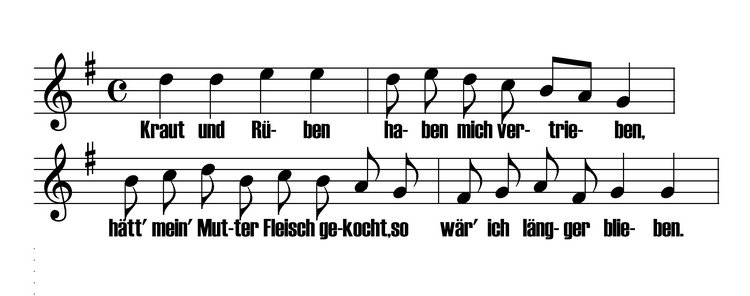
|
|
The text has been documented with various variant forms (cf. Erk-Böhme II, no. 1047.)
David Schulenberg, in his “The Keyboard Music of J. S. Bach” [Schirmer, 1992] pp. 336-337, has the following insightful analysis: |
|
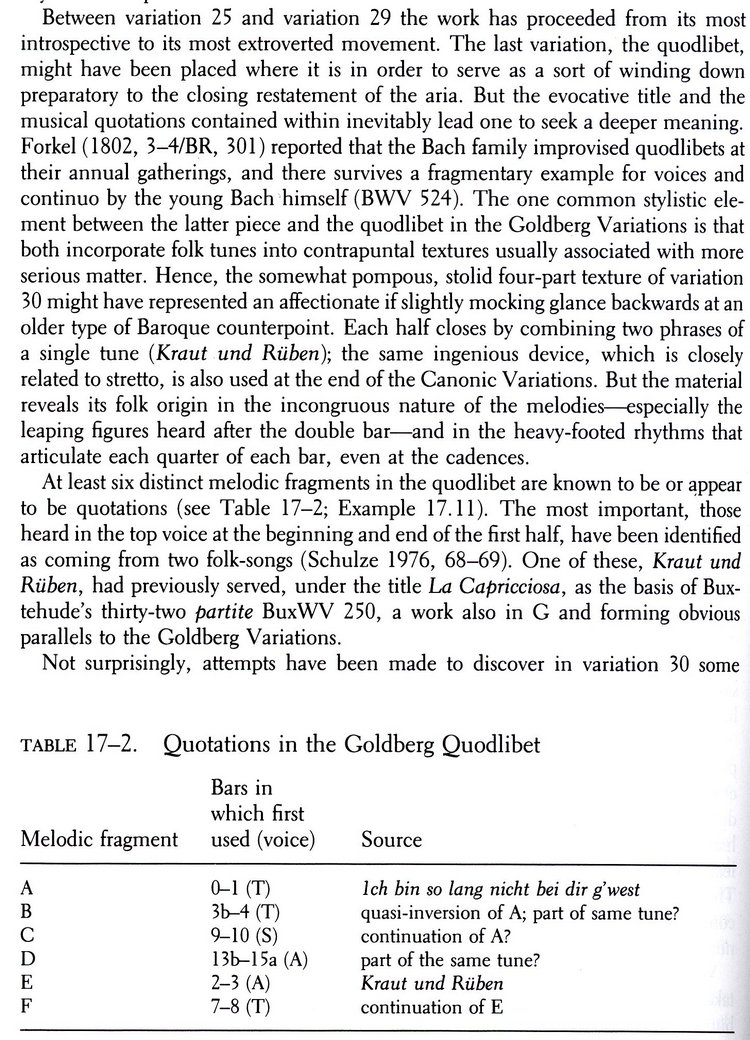
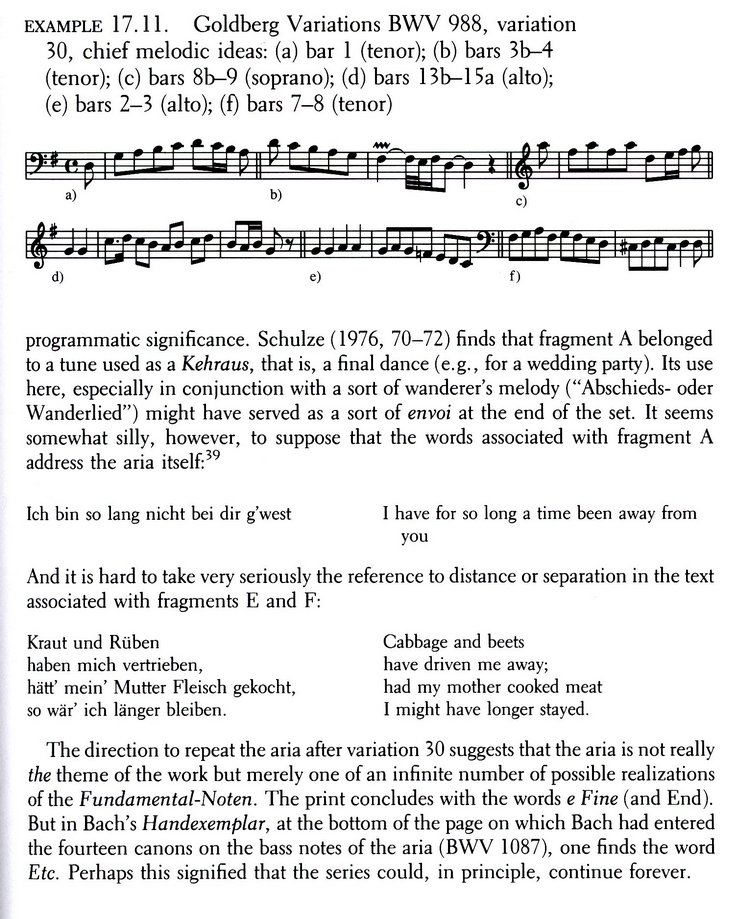
|
|
In his article on the Goldberg Variations contained in the “Oxford Composer Companions: J. S. Bach [Boyd, ed., Oxford University Press, 1999, pp. 196-197], John Butt emphasizes the integration of Variation 30 within the entire set of variations and the reprise of the aria to follow it: |
|
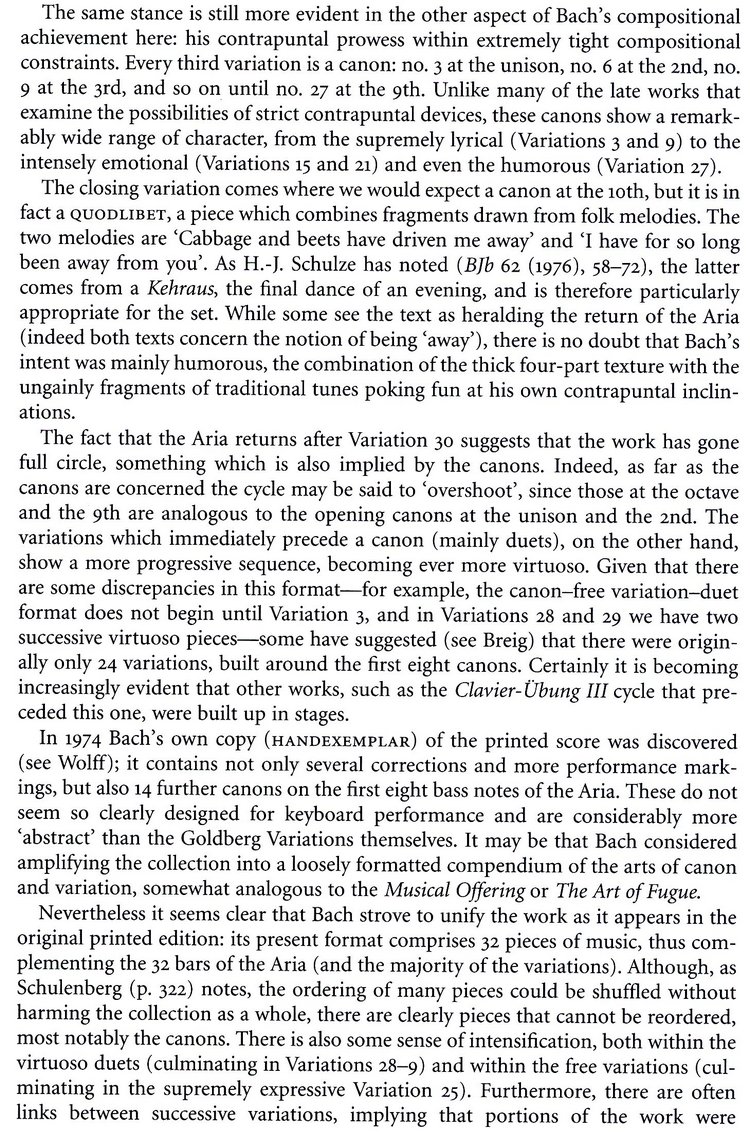
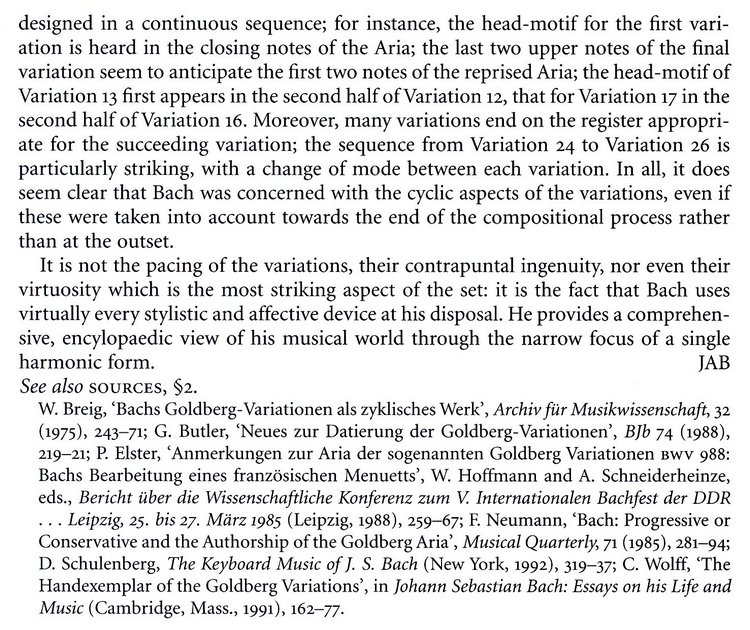
|
|
Peter Williams, in his book “Bach: The Goldberg Variations” [Cambridge University Press, 2001, pp. 88-92] dedicated entirely to this set of variations, gives, as would be expected, an even more detailed accounting of Variation 30: |
|
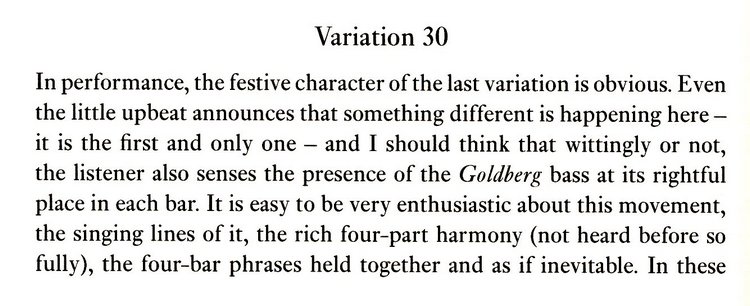
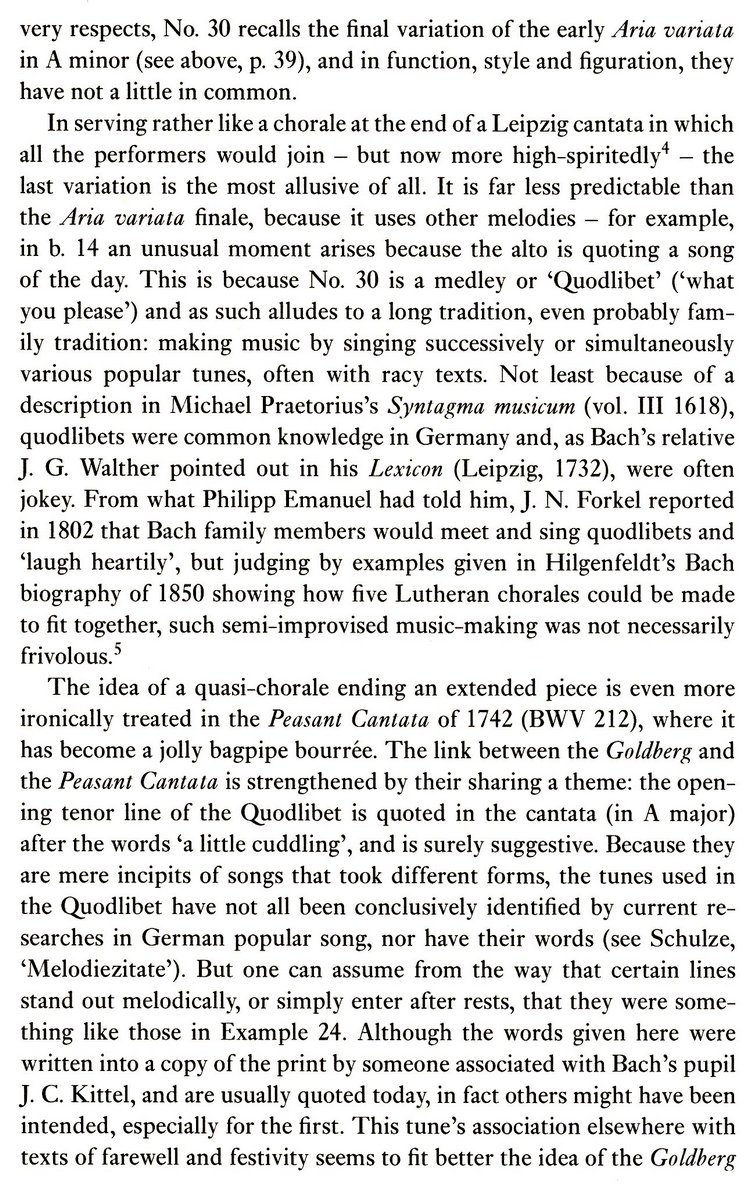
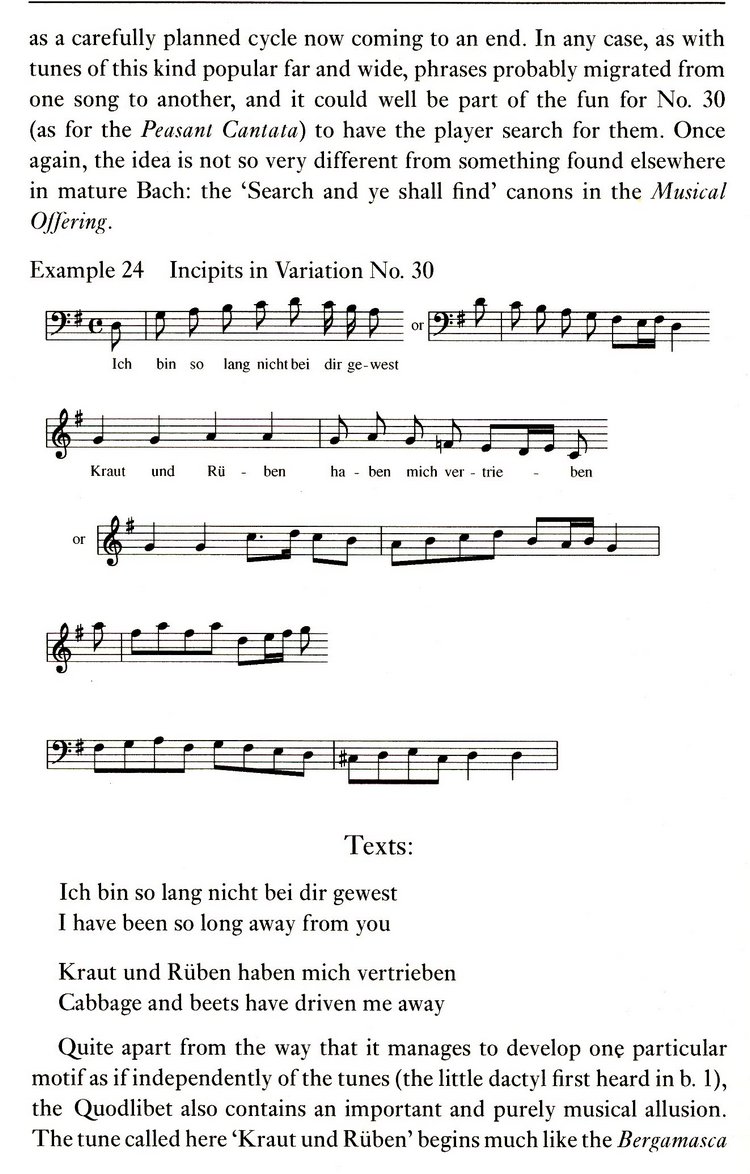
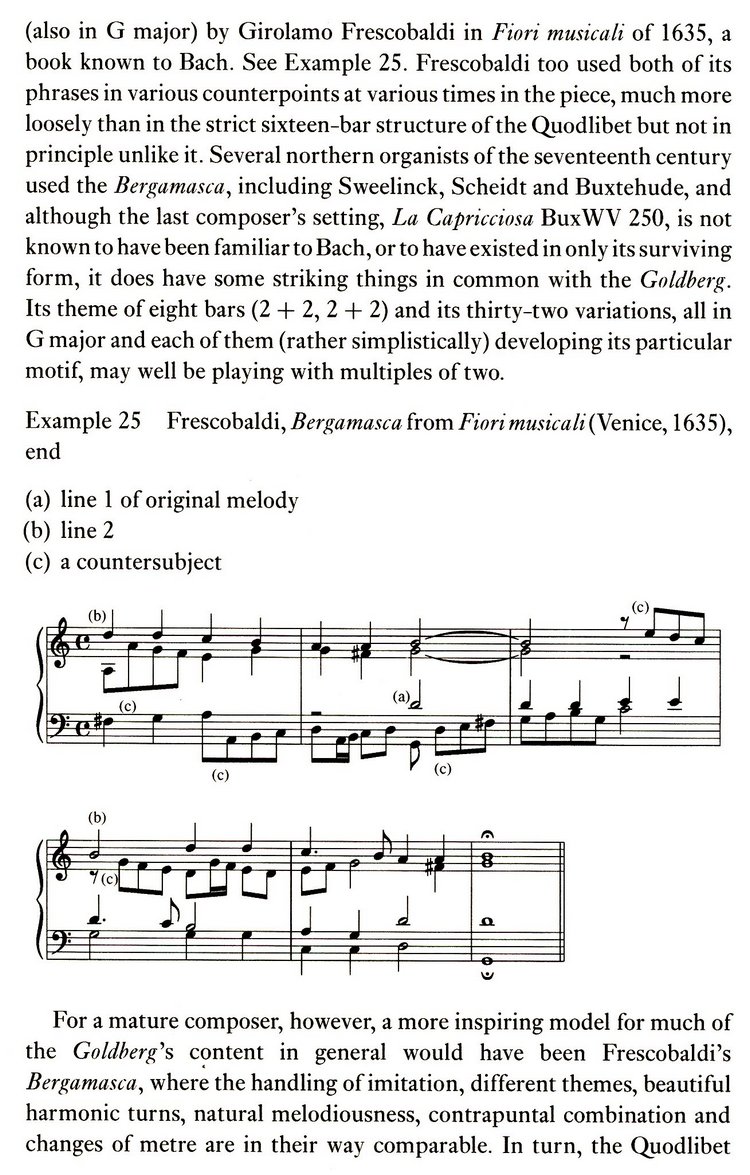
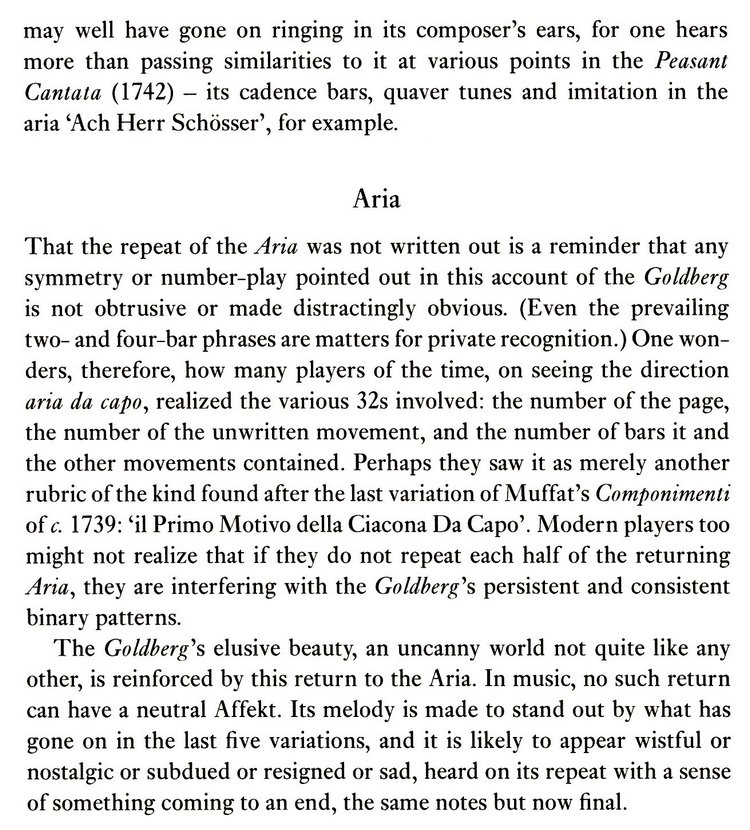
|
| |
|
Recordings and Interpretations |
|
Peter Bright shared a newspaper article from “The Guardian.” It has some relevant comments by Andras Schiff given to a reporter, Martin Kettle:
>>"We have to get rid of the idea that he was writing these variations as a monument to himself," Schiff continues. "He was not at all concerned with posterity, and it is important not to treat every bar too reverentially." That is especially true, Schiff suggests, of the 30th and last variation, the so-called Quodlibet. "We are expecting a variation that is true to the structure of the piece, which would be a canon in tenths. Instead, Bach produces 'a most human climax', a movement whose title means literally 'what pleases'. The ground bass is still there, of course, but the character of the movement is formed by two folk tunes that would have been easily recognisable to Bach's contemporaries.
"One of these songs is about cabbages and turnips. The other is about how long it is since he has been away. I feel it's all very sociable and merry, like a family get-together. I can imagine Bach and his family all sat round the table with a glass of beer. I have heard performances which are deadly serious here. But that completely misses the point. There is the most profound humour here, the kind of humour that we later find in Haydn and Beethoven. A great artist does not have to write only about man's sufferings, you know."<<
Brad Lehman commented:
>>And it's pretty easy to imagine: maybe he extended to 30+2 "to keep up with the Buxtehudes" (Capricciosa, 32 vars)...I mean, Bach's variation 30 quodlibet quotes this Buxtehude piece directly, and everything. An homage to the big man for some stylistic debts?<<
Roy Johansen opined:
>>It seems to me that the Quodlibet is such essential Bach, especially of the period in which the Goldbergs were written, so vital to the overall plan of the set, that it wouldn't have been part of a mere afterthought.<<
Don Satz gave a specific commentary on various recordings of Variation 30:
>>The 30th and last variation is known as a "Quodlibet". This term relates to popular songs being superimposed on one another as might happen when a group gathers to celebrate. Bach's music is certainly celebratory and joyous. Most of the versions are fine, but Serkin appears a little uninvolved and Koroliov has a heavy hand. Lifschitz stands out for the sense of "pomp and circumstance" he creates which I think is a fitting tribute to the conclusion of the 30 variations. I wish Lifschitz's version hadn't been the last I listened to; I had almost concluded that none of the versions was special and I never like that result.<< |
| |
|
Written by Thomas Braatz (January 8-10, 2005)
[1] A debt of gratitude is due Professor Ewald Demeyere from the Conservatory of Antwerp for pointing out the previous error regarding this specific designation. It now reads correctly. |
Goldberg Variations BWV 988 :
Details
Copmplete Recordings:
1900-1949
| 1950-1959
| 1960-1969
| 1970-1979
| 1980-1989
| 1990-1994
| 1995-1999
| 2000
| 2001
| 2002
| 2003
| 2004
| 2005
| 2006
| 2007
| 2008
| 2009
| 2010
| 2011
| 2012
| 2013
| 2014
| 2015
| 2016
| 2017
| 2018
| 2019
| 2020
| 2021
| 2022
| 2023
Comparative Review: Goldberg Variations on Piano:
Part 1
| Part 2
| Part 3
| Part 4
| Part 5
Comparative Review: Round-Up of Goldberg Variations Recordings:
Recordings
| Part 1
| Part 2
| Part 3
| Part 4
| Part 5
| Part 6
| Part 7
Reviews of Individual Recordings:
GV - R. Barami, J. Crossland, O. Dantone, D. Propper
| GV - M. Cole
| GV - J. Crossland
| GV - E. Dershavina
| GV - S. Dinnerstein
| GV - R. Egarr [Lehman]
| GV - R. Egarr [Satz]
| GV - R. Egarr [Bright]
| GV - Feltsman
| GV- P. Hantai
| GV - P. Hantaï (2nd)
| GV - K. Haugsand
| GV - A. Hewitt
| GV - R. Holloway
| GV- H. Ingolfsdottir
| GV- K. Ishizaka
| GV - J. Jando
| GV - B. Lagacé
| GV - G. Leonhardt
| GV- K. Lifschitz
| GV - A. Newman
| GV - T. Nikolayeva 3rd
| GV- J. Payne
| GV - W. Riemer
| GV - C. Rousset
| GV - S. Schepkin, M. Yudina & P. Serkin
| GV - A. Schiff [ECM]
| GV- H. Small
| GV - M. Suzuki
| GV - G. Toth
| GV - K.v. Trich
| GV - R. Tureck [Satz]
| GV - R. Tureck [Lehman]
| GV- B. Verlet
| GV - A. Vieru
| GV - J. Vinikour
| GV - A. Weissenberg
| GV - Z. Xiao-Mei
General Discussions:
Part 1
| Part 2
| Part 3
| Part 4
| Part 5
| Part 6
| Part 7
| Part 8
| Quodlibet in GV
| GV for Strings
Discussions of Individual Recordings:
GV - D..Barenboim
| GV - P.J. Belder
| GV - E. Dershavina
| GV - S. Dinnerstein
| GV - R. Egarr
| GV - V. Feltsman
| GV - C. Frisch
| GV - G. Gould
| GV - P. Hantaï
| GV - R. Holloway
| GV - J. Jando
| GV - K. Jarrett
| GV - G. Leonhardt
| GV - V. Makin
| GV - A. Newman
| GV - S. Ross
| GV - A. Schiff
| GV - R. Schirmer
| GV - H. Small
| GV - G. Sultan
| GV - G. Toth
| GV - R. Tureck
| GV - S. Vartolo
| GV - B. Verlet
Articles:
The Quodlibet as Represented in Bach’s Final Goldberg Variation BWV 988/30 [T. Braatz]
|
|





















